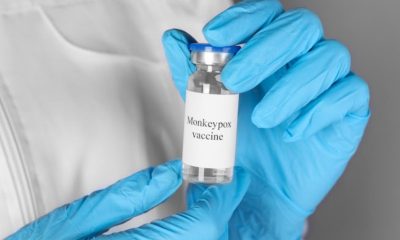Follow Us @
Abnormal smear: colposcopy and biopsy procedure
– how to remain healthy, health and wellbeing, latest symptoms and treatments.
After an abnormal smear, the gynaecologist will examine the cervix closely during a colposcopy. Usually, a biopsy is also performed during the colposcopy, in order to examine the tissue (biopsy) of the cervix more closely.
What is a colposcopy?


© Getty Images
The cervix is lined with two types of cells: squamous cells and endocervical or columnar cells. The transition area between these two types of cells is called the transition or transformation zone. Abnormal cells in the smear almost always come from this area. During colposcopy, this area is examined closely. If abnormal spots are visible, the doctor often takes a piece of tissue for examination. This is called a biopsy.
What is a biopsy (tissue examination)?
During the colposcopy, a small instrument is used to scrape away a piece of tissue (biopsy). This is often done in a few places. Sometimes, some tissue is also scraped away from the inside of the cervix.
Taking a biopsy creates a wound in the cervix, which can bleed. If there is a lot of blood loss, the doctor will sometimes dab the wound with a caustic substance. This will cause a somewhat cramping feeling in the lower abdomen. Sometimes the gynaecologist will insert a tampon into the vagina to stop the blood loss. You can pull this tampon out yourself at home. In other cases, sanitary towels are sufficient. The blood loss usually stops within a few days. As long as there is blood loss, it is better not to have intercourse.
A special type of biopsy: loop biopsySometimes a loop biopsy is taken. With this, the gynaecologist removes a larger piece of tissue. The cervix is then first locally anesthetized with a thin needle. The injection of the anesthetic can be somewhat painful. After that, you generally do not feel anything from the taking of the loop biopsy itself. A loop biopsy is performed using a thin metal loop that is heated electrically. The heated loop peels away a piece of the cervix, as it were, at the site of the abnormal tissue. At the same time, blood vessels are cauterized by the heat. To conduct the electric current, you will be given a plastic patch on your leg during the procedure. The cauterization of the tissue often produces a burning odor. If the abnormal spot is not too large, the gynecologist sometimes tries to remove the entire spot during the lis biopsy. A lis biopsy can be several centimeters large and more than half a centimeter thick. After a lis biopsy, you may have bloody discharge for one to two weeks that may smell bad. It is wise to wait with intercourse until the discharge has disappeared.
|
Results of the colposcopy and biopsy
The biopsy is examined in the laboratory by a physician (pathologist). The type of HPV is also examined. Types 16/18 are the most aggressive forms. The results are usually known within two weeks. The gynaecologist will discuss with you how you will hear the results: by telephone, in writing or during a follow-up visit.
Below we describe the most common results of tissue examination. The result is usually presented as dysplasia. Dysplasia means that the structure of the tissue is somewhat different than normal. The term ‘CIN’ is also used. This is an abbreviation for cervical intraepithelial neoplasia, an English name for dysplasia.
- CIN I or mild dysplasia: the tissue structure of the cervix is slightly abnormal, but it is not cancer.
- CIN II or moderate dysplasia: The tissue structure of the cervix is slightly more abnormal, but it is not cancer.
- CIN III or severe dysplasia: the tissue structure is even more abnormal. This is called a pre-stage of cervical cancer. A pre-stage does not mean that you will actually get cancer without treatment. Most women with CIN III will probably never get cervical cancer even without treatment.
The outdated name for a CIN III is a carcinoma in situ. This name is confusing, because there is no cancer.
In CIN I and CIN II, treatment is usually not necessary. Normally, the body removes the abnormal cells itself. You will need to undergo examinations more often (every six months or annually) to closely monitor the evolution.
CIN III has only a small chance of healing spontaneously. Whether CIN III will ever develop into cervical cancer cannot be predicted, but to be on the safe side, treatment is advised for all women with CIN III.
Types of treatments
There are different types of cervical treatments. Depending on your situation, your doctor will recommend a lisexcision, cryotreatment, conization or laser treatment.
Abnormal smear: colposcopy and biopsy procedure
Follow AFRILATEST on Google News and receive alerts for the main news about celebrities, soap operas, series, entertainment and more! Abnormal smear: colposcopy and biopsy procedure
SHARE POST AND EARN REWARDS:
Join our Audience reward campaign and make money reading articles, shares, likes and comment >> Join reward Program
FIRST TIME REACTIONS:
Be the first to leave us a comment – Abnormal smear: colposcopy and biopsy procedure
, down the comment section. click allow to follow this topic and get firsthand daily updates.
JOIN US ON OUR SOCIAL MEDIA: << FACEBOOK >> | << WHATSAPP >> | << TELEGRAM >> | << TWITTER >
Abnormal smear: colposcopy and biopsy procedure
#Abnormal #smear #colposcopy #biopsy #procedure



 Online Earning2 months ago
Online Earning2 months agoSee the details about the fall of Bitcoins



 Trending Game3 months ago
Trending Game3 months agoDying Light 2 – 7 tips to do well in the zombie adventure



 USA today entertainment3 months ago
USA today entertainment3 months agoBLACKPINK's Lisa creates history with solo single



 Fashion3 months ago
Fashion3 months agoLearn different ways to use scarves; new bet for the summer of 2024



 Culture2 months ago
Culture2 months agoDiscover the Nike Run SP routes



 Trending Game3 months ago
Trending Game3 months agoDRAGON BALL Sparkling! ZERO rips through the skies on October 11th



 Trending Game3 months ago
Trending Game3 months agoSeason of the Reptile Arrives in Mortal Kombat 1 with Trailer



 Trending Game3 months ago
Trending Game3 months agoSonic and Friends appear in Super Monkey Ball Banana Rumble





























